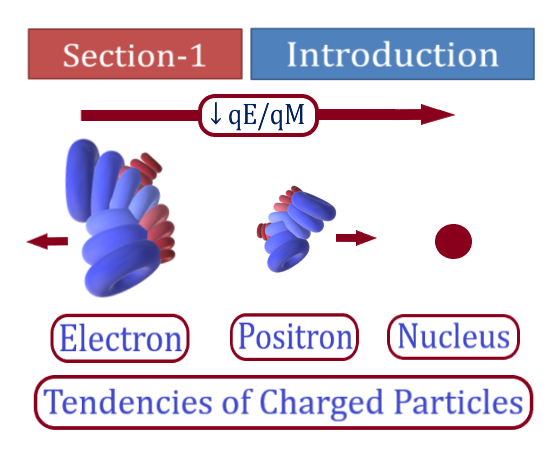The Tendencies of Charged Particles:
Experimental Facts:
It is well known that Electrons have the least tendency to be the part of a Nucleus whereas Protons and Positrons have the highest tendencies to be the part of a Nucleus.
Indications:
Though the Nucleus has the highest energy pressure, it is certainly hypothesized that Nucleus has comparatively low tqE/tqM as compared to ‘1S’ energy level of Electron which is the most proximal to the nucleus.
This hypothesis can be proven accurate by the phenomenon of the transition of electrons from the ground state to the excited state by absorption of the photon having definite qE, as the excited state is present far away from the nucleus as compared to the ground state.
If the Nucleus has more tqE/tqM as compared to the ground state, Electron moves and merges with the Nucleus along with the decrement in the atomic number. Except for the proton-rich radioactive Nucleus, this phenomenon never takes place.
It is also previously discussed that Electron, present in the ground state, has comparatively lower tqE/tqM as compared to its excited state.
These facts suggest that negatively charged Electrons have the tendency to retain or to absorb qE and be present in the energy level having higher tqE/tqM as compared to the Positrons or Protons; whereas positive charged Positrons and Protons have tendencies to emit the excess qE and be present within the Nucleus having comparatively lower tqE/tqM as compared to the Electrons.
Proton rich radioactive nucleus which has lower Neutron/Proton is hypothesized as a positron rich radioactive nucleus having a lower electromagnetically neutral mass (EMNM)/positron ratio as compared to normal (non-radioactive) Nucleus. In the positron rich radioactive nucleus, excess qE is present within the nucleus due to the strong repulsion force between the Positrons due to the excess EMNM/Positron ratio. This additional qE is responsible for higher tqE/tqM of the nucleus as compared to ‘1S’ energy level of the electron. Due to the higher tqE/tqM of the nucleus, either electron capture or positron emission process is possible.
In the electron capture process, Electron of 1S energy level is captured within the nucleus and binds with positron to convert within the electromagnetically neutral mass. During this process, the excess qE is emitted in the form of Electron neutrino to stabilize the nucleus.
In the Positron emission process, due to the strong repulsion forces between the positrons, excess qE is accumulated within one nucleon (proton) of the nucleus. Therefore, the positron is emitted from this nucleon along with excess qE in form of Electron neutrino and the remaining EMNM of this nucleon is present within the nucleus as Neutron.
Neutron rich radioactive nucleus which has higher Neutron/Proton is hypothesized as Positron deficient radioactive nucleus having higher EMNM/positron.
In the Positron deficient radioactive nucleus, due to the higher EMNM/Positron, comparatively strong attraction forces are present between nucleons because of relatively lower repulsion forces between positrons. Therefore, excess energy pressure is exerted within the nucleus along with very less tqE/tqM within the Nucleus as compared to the nucleus having normal Neutron/Proton.
So, in this state, the nucleus is explained as the energy-deficient nucleus which has a higher affinity for qE. In most cases, the required qE is obtained from a photon of higher frequency.
Due to the absorption of a photon having definite qE within a nucleon of the nucleus, a small and definite fraction of electromagnetically neutral mass of that nucleon is converted into the pair of Positron and Electron, followed by β– emission. Due to the increment in the positron number within the nucleus, repulsion forces between positrons balance the very strong attraction forces between nucleons. Therefore, the nucleus is stabilized due to comparatively lower electromagnetically neutral mass/positron along with the reduction in energy pressure and increment in tqE/tqM within Nucleus as compare to its energy-deficient state.


